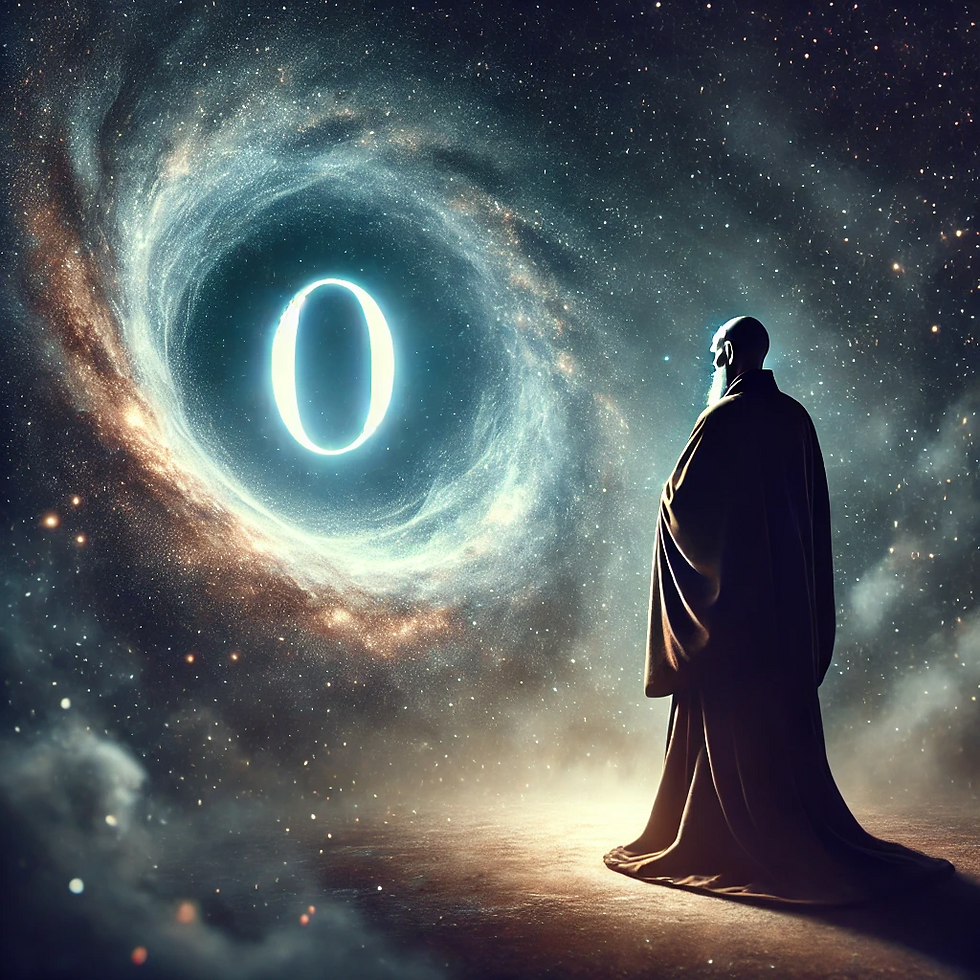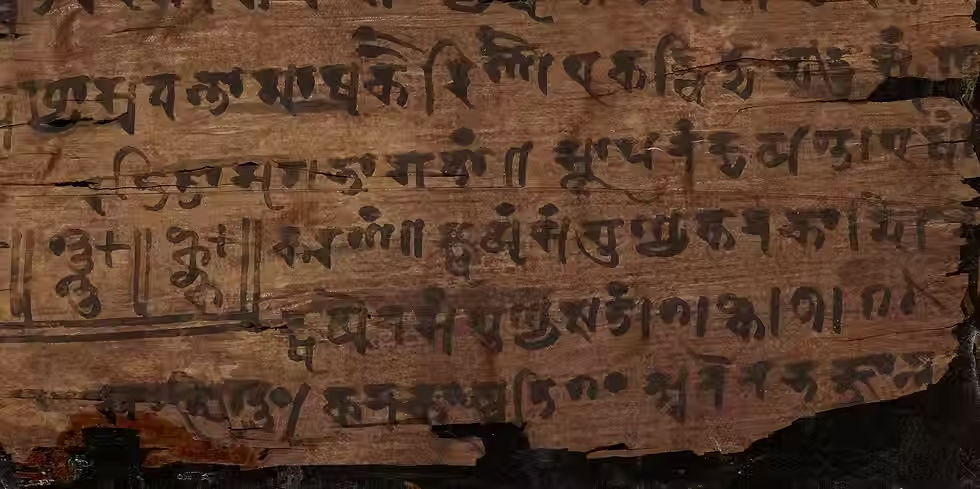The Story of Zero
- Archis Anupam Mohapatra
- Mar 26
- 8 min read

Zero, the symbol of nothingness, might seem insignificant at first glance. Yet, it is the foundation of everything in our world, from how we calculate and communicate to the very fabric of the universe. Without zero, modern mathematics, technology, and science would be impossible. From the binary code that powers our computers to the vast emptiness of space, zero is all around us—guiding, balancing, and defining the essence of existence.
In he first part of this 2 part article we will learn of the ancient number systems, some paradoxes posed by great philosophers, and finally setting free of the zero in the Indian subcontinent by some brilliant mathematician.
The Ancient Sumerians (4000BCE)

We begin our journey between the Tigris and Euphrates rivers (modern-day Iraq and Iran). Here lay one of the oldest human civilizations. The Sumerians had not only understood the method of farming but writing, governance, and even the wheel were believed to be invented by them. As the civilization grew so did the need to govern them. The vast sums of crops they yielded needed to be accounted for. Trade too was picking up and so too was the need for better accountability. The Sumerians had devised an ingenious way to record numbers on clay tablets. If they for example needed to record 5 fishes, they draw 5 fishes. However, as the number of crops and items started to grow, this system turned out to be quite inefficient. So they devised a new method. They emancipated the numbers from the items they represented and devised a loose sexagesimal system. The Sumerians used a sexagesimal system (one made around the number 60). This base 60-number system is why we still have 60 seconds in a minute, 60 minutes in an hour, and 360 degrees in a circle today[1]. They used two primary symbols:

A vertical wedge (𒑰) for units (1–9).

A corner wedge (𒐕) for tens (10, 20, etc.).
Unlike earlier tally marks, Sumerians used a positional system, meaning the value of a symbol depended on its place in a number (like in modern decimals). However, they initially lacked a symbol for zero, which caused some ambiguity.
Okay so now that we have the symbols lets see some examples.
54=(5 x 10)+(4x1)= 𒐐𒐼
36=(3x10)+(6x1)= 𒌍𒐋
67=(1x60) +(7x1)=𒁹𒅓
182=(3x60) + (0x10)+(2 x 1)=𒁹𒁹𒁹 𒈫 (its already getting confusing)
3812=((1)\times(60^2))+(3\times60)+ (4\times10)+(2\times1)$ = 𒁹 𒁹𒁹𒁹 𒐏 𒈫
now imagine you were in a hurry and were intending to write 3602 and carve this into a clay tablet=𒁹𒈫 instead of 𒁹 𒈫, you would have written 62 instead of 3602. That’s a huge error, one at times punishable by death. Many accountants would have been beheaded before they modified their numerical system. The lack of a placeholder meant lots of confusion.

Babylonian numerals
The Babylonian later added a special character to avoid all this confusion.

However, unlike the numbers before this new symbol didn’t have a meaning of its own! It would only ever be used as a placeholder.
Such placeholders had been invented by many other civilizations like the Mayans or the Egyptians.Even the Chinese didn't put any notion to this except for a being a placeholder.[2] But even the Greeks who somewhat adopted the Sumerian numbers didn’t set the placeholder free. By the time Alexander conquered Mesopotamia (332BC), Greek mathematicians had already started to take a look at this new number system. Interesting though it was, it was always used in secrecy. Greeks used some letters to correspond to certain numbers and made combinations of these to make other numbers. Greeks came up with their symbol for the Babylonian zero, 𐆊 [3]. Even though the Greeks would use it at the ends of numbers, it was never truly set free. The concept of nothingness evaded the Greeks. To show why, let's talk a little about Zeno’s Paradox.
Zeno of Elea (490-430 BCE)
Zeno of Elea was a pre-Socratic Greek philosopher from Elea, a city in Magna Graecia (Southern Italy). A devoted student of Parmenides, Zeno was a key figure in the Eleatic school of philosophy. He staunchly defended Parmenides' doctrine of monism—the belief that reality is a single, unchanging entity.[4] To that end he created a series of paradoxes and challenges, we will take a look at a couple of them
Paradox of Dichotomy:
It Holds that you can’t take ever move because before you can take a single step, you need to take a half step. And before you can do that you need to take a quarter step, so on and so forth till you can’t even start walking.
The Arrow Paradox
An arrow is always still at any instant, it does not move. Time is made of instants. If it never moves in an instant, it never moves at all.
While you can from experience and logic solve these paradoxes today, it was a real challenge for the people of that time. Amongst all the paradoxes Zeno proposed, one of them is really needs to be looked at closely for in time it will play an intimate role in the understanding and misunderstanding of zero.
Achilles and the Tortoise➖

Let our Greek hero Achilles stand 10m behind a tortoise, who he is to race. As the race begins the tortoise has moved a 1m in 1sec, while our hero has covered the 10m. In the next 0.1 sec Achilles has made up the 1m tortoise has moved, but the tortoise moved further away still, this time 10 cm. By the time Achilles has run those 10 cm, the tortoise has moved 1cm. and so and so forth and our poor hero will never catch up to the tortoise. This seems illogical, surely Achilles would catch up to the tortoise in no time but the math above leads us to believe that it would take infinite steps to reach the tortoise. Surely it's impossible. Since this couldn’t be disproved at that time, Zeno proved that our senses couldn’t be trusted. A century later a new challenger would arise.
Aristotle’s beliefs.
In time Zeno would come to die a violent death for his conspiracy to overthrow tyrant leader Nearchus. A century later Aristotle (father of Western Philosophy) tackled this paradox with legislation, by declaring there could never be an infinite number. Reality was the continuum of the race and it could never be broken into such small pieces. To Aristotle infinity was always something that could be held in the mind but never realized. But with our understanding of zero we can bridge this gap quite easily.
Taking a closer look at the paradox, as Achilles runs at 10m/s and since distance equals rate times time, his distance down the track is 10t. As for the tortoise he was at 10m already and ran at 1m/s.
⇒ 10t= 10+ 1xt
⇒9t=10
⇒t=1+1/9 (seconds)
So, not only does Achilles overtake the tortoise, but he does so in less than 2 sec. Without the understanding of zero, we can never arrive at such a conclusion. His mistrust of the infinite led to deep-seated mistrust in zero, for in rejecting the infinite he also rejected the infinitely small steps within the limits. There was little to no choice for Aristotle you see, he was at war with Atomists. Those who believed in dividing matter into infinitely small building blocks called atoms floating in an infinitely large void/emptiness. The Christians later adopted Aristotle's theory of matter and the celestial sphere as they swept through the globe and decreed the atomic and void to be blasphemy.[5] To the medieval Westerner, the idea of void/emptiness held no value, therefore the thought of a number not having a value, and being empty had little to no use.
Sunyata

While emptiness or the void held no value to the western minds. Here in the sub-continent things where different. The concept of Śūnya, the Sanskrit word for zero, also means void. This idea of emptiness appears repeatedly in ancient Indian texts, and even Buddhists embraced it as a core aspect of their spirituality.Emptiness of emptiness, to be let go all attachment and feelings, that's the path a Buddhist monk takes through his meditation.[6] Perhaps it was this deep philosophical exegesis that led them to a greater understanding of zero. Our story once again continues from the middle of the first millennium. Indians by now had developed a rich set of number system and had made great mathematical inroads. The number system they had started to use was very similar to the one we use today. It was a decimal system and made clever use of position system.
Books and manuscripts from this time show up from places to places in the sub-continent and are greatly regarded by the historians today as proof of zero invention in this land. Historians today may accept that the modern day zero was birthed in India but it wasn't always the case. George R. Kaye, an influential British scholar and orientalist from the early part of the 20th century, held some dangerous views when it came to Indian numerals. His agenda was to establish European supremacy in the realm of mathematics and to that end he was willing to go to any lengths. By discrediting earlier Indian documents he would argue that the modern number system was not an Indian invention but had been imported into India from Greece or Arabia. And to that end, he found many supporters.[7]
But we have through meticulous research and documentation proved that zero was invented in the sub-continent. Though, the exact date of its invention may be missing us.
The Bhaskalli manuscript, an ancient mathematical text written on birch bark, discovered in 1881 in the village of Bakhshali (now in Pakistan). It is one of the oldest known Indian mathematical manuscripts and contains numerical calculations, arithmetic rules, and algebraic techniques.[8] Until 2024, this manuscript served as the oldest relic to show the number 0. However a recent carbon dating done in 2024 has raised many question regarding its age, as it found the manuscript to be written in the period of late 8th century to 11century.[9]


Linguists and historian claim that the Bhakshali manuscript isn't a original but a copy a older text based on the language used.[10] Irrespective of that there are other sources of zero's antiquity in Indian sub-continent. One of them being a inscription on the wall of a temple in Gwalior, and more famously the most seminal work on mathematics Brāhmasphuṭasiddhānta (Correctly Established Doctrine of Brahma) written by the genius of that era Brahmagupta.[11]
Brāhmasphuṭasiddhānta
Brahmagupta is credited with fleshing out the details of zero in his seminal work, the Brāhmasphuṭasiddhānta written in the 6th century AD. Brahmagupta was the first to define zero (śūnya) and its mathematical operations. It was in this book we encounter treaties on how to do arithmetic with the number 0, thereby fully giving it a identity of its own. So, it was, "0" was as real as 1 or 2. You take any number, you add or subtract zero you get the same number, you multiply by it you get zero and you divide by zero to get…..well that one was tricky.[12]
This division by zero is tricky business, as tricky a business then as it is now. When Brahmagupta encountered this, his mathematics began to fail. He declared zero divided by zero to be zero. Now, we know this isn’t necessarily true. Take two pencils of the same length, where the ratio of their heights is 1. Now, imagine their height suddenly halves—the ratio remains 1. As their heights keep halving, the ratio still remains 1. It will continue to do so until we reach zero. Thus, one could argue that 0/0 = 1.
But here’s the catch: I can just as easily construct a case where 0/0 equals 2, or infinity, or anything at all. The value is indeterminate—it depends entirely on the context.
The problem deepens when we attempt to divide 1 by zero. It wasn’t until Bhāskarāchārya that we got an answer. Rather than treating it as an arithmetic result, he invoked Khahara—the infinite—the almighty Vishnu.[13] This ‘pesky little problem’ continues to resurface, causing havoc even in the modern world.
Brahmagupta’s liberation of the zero marks a revolutionary moment in the history of mathematics. This pivotal moment, sets into motion one of the most turbulent ride zero has seen yet.
In the next part of this article we will learn a little more of this book (Brāhmasphuṭasiddhānta) and see how once free from its shackles, zero takes a trip around the world to finally become what it is today.






Very detailed knowledge is shared